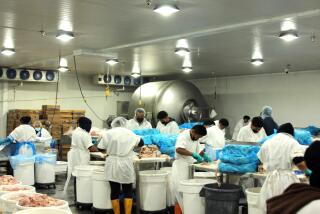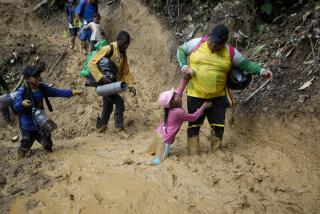Use of Underage Workers Dips in Latin America
WASHINGTON â Responding to publicity and protests, Latin American clothing manufacturers have reduced their use of child labor to make goods for the U.S. market, Labor Secretary Robert Reich said Monday.
However, child labor--workers under the age of 15--âcontinues to be a major problem in south Asia,â Reich told a news conference.
Without legal authority over working conditions outside the United States, Reich has relied on publicity and moral suasion to raise the issue with American clothing producers and retailers.
âPrivate industry now recognizes that it can take steps to make sure boys and girls are not robbed of their childhood,â Reich said, discussing a new department report on codes of conduct for the apparel industry. He said a growing number of U.S. importers have adopted policies to prohibit the use of child labor by their foreign subcontractors.
But âcodes are not a panacea,â Reich said. âNo code of conduct is worth the paper itâs printed on without strict enforcement of its requirements.â
Labor Department investigators visited 70 apparel plants in four Latin American countries--El Salvador, Guatemala, Honduras and the Dominican Republic--and in the Philippines and India in Asia. They also met with human rights groups and unions in those countries.
The investigators found that âchild labor is not now prevalentâ in the garment industries of the four Latin American countries. And although they found ample evidence of child labor in India and the Philippines, most of it took place âin subcontracting shops or homework situations,â their report noted.
In addition, the department asked 48 clothing manufacturers and retailers in the United States about the use of children to make the products they imported. Most said they did not permit the use of child labor, although the Labor Department report said foreign factories often ignored or failed to enforce this rule.
In a report based on these two sets of data, the Labor Department said publicity in the United States, including congressional testimony, had produced favorable changes.
In El Salvador, plant managers âhave apparently begun to refuse to hire workers under 18 years of age, despite the fact that workers can legally begin working at 14,â the report said.
âSeveral plant managers explained [to Labor Department officials] that they will not hire workers under 18 because they believe that this is the policy of U.S. retailers,â the report noted.
Reich acknowledged that the reform efforts could backfire in poor countries. âThere is no easy way to eradicate child labor,â he said. âClosing down factories will not do it. The economic conditions remain. If we are not careful, we can force children into the underground economy, which is even worse.â
In Bangladesh, the countryâs clothing producers and exporters pledged to eliminate the use of child labor two years ago after U.S. news reports focused on the situation, the Labor Department study said.
âThousands of children were reportedly dismissed from factories and were forced to resort to more dangerous and lesser-paid work in the informal sector,â the report said. Some of the children who lost their jobs apparently went to work for âunderground subcontractors,â working in hidden garment sweatshops under worse conditions than before.
Some schools have been established for former child workers but âclearly, progress has been slow,â the report said.
Surveys show that American consumers favor an end to child labor, and their buying choices could be helped with labels certifying that goods were not made with child labor, Reich suggested. These labels are already available with some foreign-made rugs.
The United States is the worldâs largest apparel importer. Of the $178 billion worth of garments sold in the country last year, about $92 billion--slightly more than half--was produced abroad.
More to Read
Sign up for Essential California
The most important California stories and recommendations in your inbox every morning.
You may occasionally receive promotional content from the Los Angeles Times.










